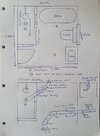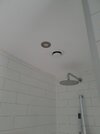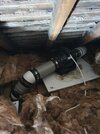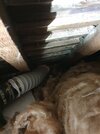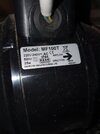Hi all,
So I installed a Manrose MF100T Inline Extractor Fan (bought from Amazon) in our main bathroom last year but it's never really done much to help with the condensation literally running down the walls. I've tried playing around with the ducting (swapping from flexi to rigid, 45° bends instead of 90°), moving the inlet vent further into the shower enclosure (previously in the back corner) and putting it on it's highest speed.
I tend to keep to a sub-10 minute shower but my girlfriend likes to have 30 minute volcanic sauna showers which turns the bathroom into a "gorillas in the mist" type situation, with condensation running down the walls and the ceiling looking like bubblewrap there's that much drippage. Now some important observations:
- The Fan has always sounded loud, mechanically sounds OK just loud, unsure whether that's just rigid ducting.
- Barely any steam seems to get sucked into the inlet vent, you can't see it being pulled in, imstead it just floats around the ceiling, spilling into the main part of the bathroom where there's no other ventilation.
- I've been out to the external vent and that seems okay, there's air being forced out of it but not quite as much as I expected given the noise.
- Ducting seems OK, water has leaked out of the casing of the fan though which you can see in the photos, but none out of the ducting (normally has rockwool insulation covering it but removed for photos).
- The bathroom door has a 16mm gap under the bottom which I thought adequate for 100mm ducting.
-The bathroom itself has 2 Heat Loss solid brick walls facing the North and East, has no wall insulation but 300mm loft insul above, and is in a 1930s semi detached house.
Now you can see from my plans I've proposed a new ducting layout (a 90° bend out the inlet vent, then 2x 45° bends with the fan going straighter towards the external vent). Before I start chopping and changing I wanted to get some answers to some questions:
1a. Would the proposed layout make a difference?
1b. Does 2x 45° bends make a difference compared to a tight 90° bend?
2. Would swapping the ducting to insulated flexi ducting be better than insulating non-insulated rigid ducting?
3. If the fan is working and air is being moved within the ducting, why does it feel like there's barely any air being sucked into the ducting?
4. Would having a second inlet vent between the 2 spotlights in the main bathroom area, connected with a T junction in the ducting, improve things or would it draw away too much air flow?
5. Would a 5" or 6" fan be worth the cost of swapping too or is the size of ducting not the issue?
6. Is this just something we're going to have to live with being a North and East externally facing bathroom?
Sorry if this is a lot but I keep trying different things and nothing seems to work, so I'm hoping someone here might see or know something I'm missing. Thanks a lot!
So I installed a Manrose MF100T Inline Extractor Fan (bought from Amazon) in our main bathroom last year but it's never really done much to help with the condensation literally running down the walls. I've tried playing around with the ducting (swapping from flexi to rigid, 45° bends instead of 90°), moving the inlet vent further into the shower enclosure (previously in the back corner) and putting it on it's highest speed.
I tend to keep to a sub-10 minute shower but my girlfriend likes to have 30 minute volcanic sauna showers which turns the bathroom into a "gorillas in the mist" type situation, with condensation running down the walls and the ceiling looking like bubblewrap there's that much drippage. Now some important observations:
- The Fan has always sounded loud, mechanically sounds OK just loud, unsure whether that's just rigid ducting.
- Barely any steam seems to get sucked into the inlet vent, you can't see it being pulled in, imstead it just floats around the ceiling, spilling into the main part of the bathroom where there's no other ventilation.
- I've been out to the external vent and that seems okay, there's air being forced out of it but not quite as much as I expected given the noise.
- Ducting seems OK, water has leaked out of the casing of the fan though which you can see in the photos, but none out of the ducting (normally has rockwool insulation covering it but removed for photos).
- The bathroom door has a 16mm gap under the bottom which I thought adequate for 100mm ducting.
-The bathroom itself has 2 Heat Loss solid brick walls facing the North and East, has no wall insulation but 300mm loft insul above, and is in a 1930s semi detached house.
Now you can see from my plans I've proposed a new ducting layout (a 90° bend out the inlet vent, then 2x 45° bends with the fan going straighter towards the external vent). Before I start chopping and changing I wanted to get some answers to some questions:
1a. Would the proposed layout make a difference?
1b. Does 2x 45° bends make a difference compared to a tight 90° bend?
2. Would swapping the ducting to insulated flexi ducting be better than insulating non-insulated rigid ducting?
3. If the fan is working and air is being moved within the ducting, why does it feel like there's barely any air being sucked into the ducting?
4. Would having a second inlet vent between the 2 spotlights in the main bathroom area, connected with a T junction in the ducting, improve things or would it draw away too much air flow?
5. Would a 5" or 6" fan be worth the cost of swapping too or is the size of ducting not the issue?
6. Is this just something we're going to have to live with being a North and East externally facing bathroom?
Sorry if this is a lot but I keep trying different things and nothing seems to work, so I'm hoping someone here might see or know something I'm missing. Thanks a lot!


